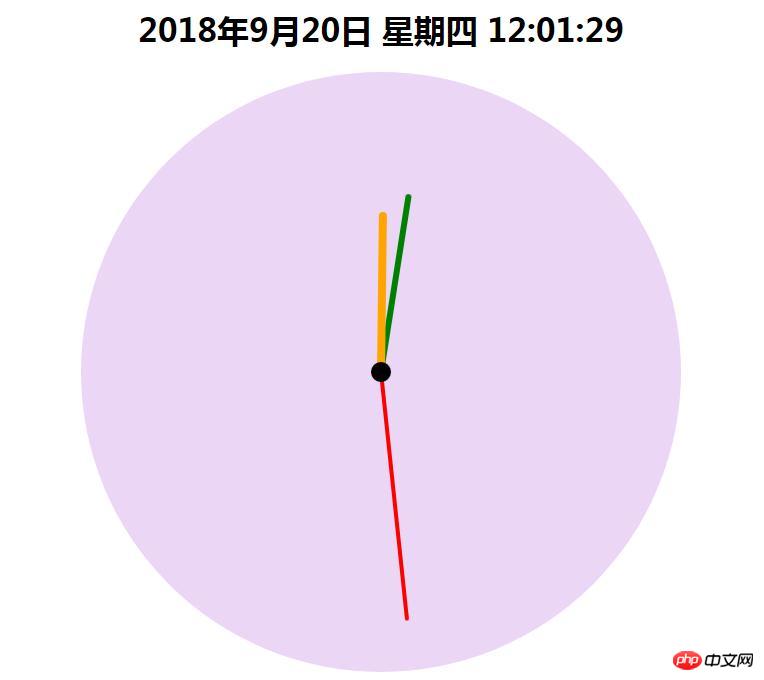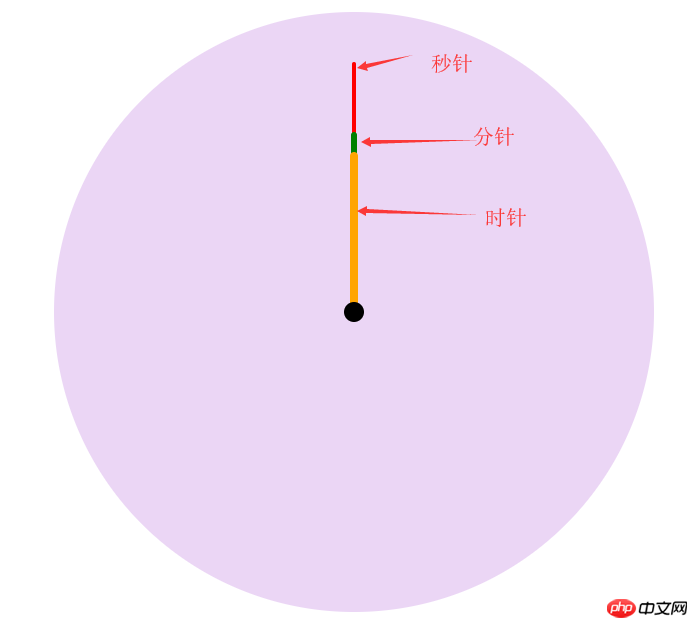
This chapter introduces how to use css3 and js to achieve dynamic clock effects. It has certain reference value. Friends in need can refer to it. I hope it will be helpful to you.
Let’s take a look at the renderings first:

First of all, I thought about the layout of the page. It roughly requires 4 layers of divs, and the bottom layer is a dial background image. , and then the remaining three layers are the hour hand, minute hand, and second hand layers.
The html code is as follows:
<div class="dial">
</div>
<div class="bigdiv bigdiv1" id="secondHand">
<div class="secondHand"></div>
</div>
<div class="bigdiv bigdiv2" id="minuteHand">
<div class="minuteHand"></div>
</div>
<div class="bigdiv bigdiv3" id="hourHand">
<div class="center"></div>
<div class="hourHand"></div>
</div>The variable name is randomly chosen, don’t mind; the div with class=center is The little black dot in the center of the watch.
The hour hand rotates once in 60*60*60s, the minute hand rotates in 60*60s, and the second hand rotates in 60s, so the css code is as follows:
.dial{
width:600px;
height:600px;
margin:0 auto;
position: absolute;
border-radius: 50%;
overflow: hidden;
background-color: rgba(153,50,204,0.2);
background-image: url(img/表盘.jpg);
background-size: 100% 100%;
}
.bigdiv{
width:600px;
height:600px;
margin:0 auto;
position: absolute;
border-radius: 50%;
overflow: hidden;
}
.bigdiv>div{
position: absolute;
left:298px;
border-radius: 100px;
}
.bigdiv1{
animation: moves 60s steps(60) infinite;
}
.bigdiv1 .secondHand{
width:4px;
height:250px;
background-color: red;
top:50px;
left:298px;
}
.bigdiv2{
animation: moves 3600s steps(3600) infinite;
}
.bigdiv2 .minuteHand{
width:6px;
height:180px;
background-color: green;
top:120px;
left:297px;
}
.bigdiv3{
animation: moves 216000s steps(216000) infinite;
}
.bigdiv3 .hourHand{
width:8px;
height:160px;
background-color: orange;
top:140px;
left:296px;
border-radius: 100px;
}
.bigdiv .center{
top:290px;
left:290px;
width:20px;
height:20px;
background-color: black;
z-index: 2;
}
@keyframes moves{
from{ transform: rotateZ(0deg); }
to{ transform: rotateZ(360deg); }
}After this step is completed, the rendering will look like this:

Then use js to calculate the current time,
var date = new Date(); var hours = date.getHours(); var minutes = date.getMinutes(); var seconds = date.getSeconds();
Then calculate the current time of each needle Rotation angle
var secondAngle = seconds; var minuteAngle = minutes * 60 + seconds; var hourAngle = (60/12) * ((hours%12) * 3600 + minuteAngle);
The current idea is: each needle will rotate once according to its own time, and the initial angle can also be known. How to form a dynamic clock that displays the current time?
The initial idea was to rotate the three layers of divs at the corresponding angles and then start again. But then I couldn’t think of it, because it still rotates once at a fixed time, and the pointer pointing will be deviated.
What we need now is the page The first circle that comes in rotates at a fixed angle, and the rest just rotates one circle according to the original fixed time.
There is an animation-delay attribute in css3, which means animation delay, and a negative number means it starts early ( For example, -5s means that the animation starts from the 5s time),
can be used just in time to let these pointers start the corresponding angles in advance.
The js code is as follows:
hourHand.style.cssText = "animation-delay: -"+ hourAngle +"s"; minuteHand.style.cssText = "animation-delay: -"+ minuteAngle +"s"; secondHand.style.cssText = "animation-delay: -"+ secondAngle +"s";
Finally, I added a dynamic time to display on the clock
Full code:
<!DOCTYPE html>
<html>
<head>
<meta charset="UTF-8">
<title></title>
<style>
body,
html {
margin: 0;
}
.location {
position: relative;
width: 600px;
height: 600px;
left: calc(50% - 300px);
}
.dial {
width: 600px;
height: 600px;
margin: 0 auto;
position: absolute;
border-radius: 50%;
overflow: hidden;
background-color: rgba(153, 50, 204, 0.2);
background-image: url(img/表盘.jpg);
background-size: 100% 100%;
}
.bigdiv {
width: 600px;
height: 600px;
margin: 0 auto;
position: absolute;
border-radius: 50%;
overflow: hidden;
}
.bigdiv>div {
position: absolute;
left: 298px;
border-radius: 100px;
}
.bigdiv1 {
animation: moves 60s steps(60) infinite;
}
.bigdiv1 .secondHand {
width: 4px;
height: 250px;
background-color: red;
top: 50px;
left: 298px;
}
.bigdiv2 {
animation: moves 3600s steps(3600) infinite;
}
.bigdiv2 .minuteHand {
width: 6px;
height: 180px;
background-color: green;
top: 120px;
left: 297px;
}
.bigdiv3 {
animation: moves 216000s steps(216000) infinite;
}
.bigdiv3 .hourHand {
width: 8px;
height: 160px;
background-color: orange;
top: 140px;
left: 296px;
border-radius: 100px;
}
.bigdiv .center {
top: 290px;
left: 290px;
width: 20px;
height: 20px;
background-color: black;
z-index: 2;
}
@keyframes moves {
from {
transform: rotateZ(0deg);
}
to {
transform: rotateZ(360deg);
}
}
#dateshow {
text-align: center;
}
</style>
</head>
<body>
<h1 id="dateshow"></h1>
<div class="location">
<div class="dial"></div>
<div class="bigdiv bigdiv1" id="secondHand">
<div class="secondHand"></div>
</div>
<div class="bigdiv bigdiv2" id="minuteHand">
<div class="minuteHand"></div>
</div>
<div class="bigdiv bigdiv3" id="hourHand">
<div class="center"></div>
<div class="hourHand"></div>
</div>
</div>
<script>
var dateshow = document.getElementById("dateshow");
var clock = {
weeks: ["一", "二", "三", "四", "五", "六", "日"],
getDate: function() {
date = new Date();
year = date.getFullYear();
month = date.getMonth() + 1;
day = date.getDate();
hours = date.getHours();
minutes = date.getMinutes();
seconds = date.getSeconds();
week = date.getDay(); // 星期
dateText = year + "年" + month + "月" + clock.format(day) + "日 星期" + clock.formatnum(week) + " " +
clock.format(hours) + ":" + clock.format(minutes) + ":" + clock.format(seconds);
return dateText;
},
format: function(data) {
if(data.toString().length == 1) {
data = "0" + data;
};
return data;
},
formatnum: function(num) {
return clock.weeks[num - 1];
},
showdate: function() {
dateshow.innerText = clock.getDate();
},
go: function() {
var secondHand = document.getElementById("secondHand");
var minuteHand = document.getElementById("minuteHand");
var hourHand = document.getElementById("hourHand");
date = new Date();
hours = date.getHours();
minutes = date.getMinutes();
seconds = date.getSeconds();
var secondAngle = seconds;
var minuteAngle = minutes * 60 + seconds;
var hourAngle = (60 / 12) * ((hours % 12) * 3600 + minuteAngle);
hourHand.style.cssText = "animation-delay: -" + hourAngle + "s";
minuteHand.style.cssText = "animation-delay: -" + minuteAngle + "s";
secondHand.style.cssText = "animation-delay: -" + secondAngle + "s";
}
}
clock.go();
clock.showdate();
setInterval("clock.showdate()", 1000);
</script>
</body>
</html>The above is the detailed content of css3+js draws dynamic clock (with code). For more information, please follow other related articles on the PHP Chinese website!